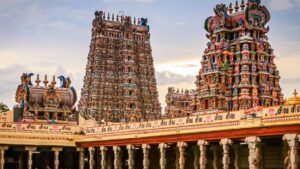India’s Temple Wealth:
For our last story tonight, let’s focus on India again. The world’s most populous nation is home to some of the world’s most incredible temples, and also some of the richest. Here, temples are not just places of worship, they are cultural and economic powerhouses. A new report is out about the famous Siddhivinayak Temple of Mumbai. Over the last financial year, this temple has earned 133 crore rupees, that’s almost 15 million dollars. It sounds like a lot, but this is a very small part of India’s temple economy.

- This is Siddhivinayak, a temple for Lord Ganesh in India’s financial capital, the western Indian city of Mumbai. It’s one of the most popular temples in the country, and also one of the richest. Over the last financial year, its annual earnings have jumped by 16 percent to reach 133 crore rupees. That’s more than 15 million dollars.
Now where does this money come from?
According to the temple, much of it is through donations and offerings by the devotees. Then there’s income of about 20 crore rupees from rituals like puja. Then of course, there’s the sale of prasad, the temple’s famous laddus and nariyalwadi, which is a crunchy coconut sweet. A chunk of the money also came from auctioning gold and silver. This happens during certain auspicious Hindu days, and it has earned the temple a record-breaking 1.33 crore rupees.
But this doesn’t come close to certain even richer temples in India, especially southern India, like the Tirumala Tirupati Venkateswara temple in the state of Andhra Pradesh. This is a historic 10th century temple, and it’s considered the wealthiest Hindu temple in the world. It has a net worth of 3 lakh crore rupees. That’s more than 35 billion dollars. The temple has an annual income of about 1400 crore rupees. This money comes from a range of sources, like donations by devotees, huge interest on its investments like fixed deposits, the sale of food from the temple kitchen, which is one of the biggest in India, and of course, the sale of hair donated to the temple by devotees.

Then, there’s the Padmanabhaswamy Temple of Kerala. This temple has assets worth 1.2 lakh crore rupees. It is infamous for vaults filled with priceless treasures, including idols and statues of gold and precious jewels. Many of them are believed to have been deposited by the royal family of the princely state of Travancore. In the same state lies the centuries-old shrine where Lord Vishnu is worshipped as Krishna, the Guruvayur Devaswamy. With its magnificent elephants, this famed temple possesses bank deposits of more than 1700 crore rupees. Apart from this, the temple holds a treasure trove of precious jewels, gold, and hundreds of acres of land.
Now, up north, the Vaishnodevi Temple of Jammu is among the richest in India. It is set at an altitude of 5,200 feet.

Over the last two decades, it has received more than 2,000 crore rupees in donations via cash, 1,800 kilograms of gold, and 4,700 kilograms of silver. So, it’s no surprise that India’s temple economy stands at tens of billions of dollars.
But what happens to it? How is this money managed?
Across all temples, some of it is used for maintenance and operation.
Some of it is invested. And then a part of the money is used for a range of purposes for social benefit. Take the Siddhivinayak Temple for example. According to its board, 20% of the earnings are spent on medical and financial aid for people who need it.
But, there have also been reports of mismanagement of funds in this temple and others. Plus, there’s hardly a system for using a temple’s wealth of funds for public good. That said, in India, these historic living temples are imposing kaleidoscopic models. They aren’t just wealthy, but a crucial part of the country’s rich culture and heritage.
